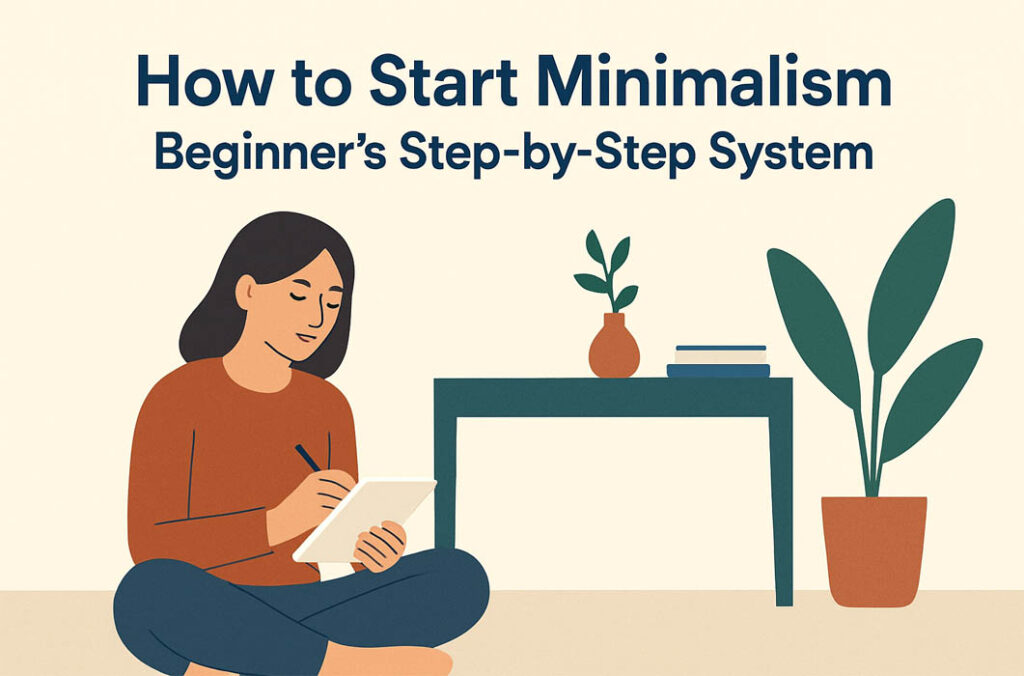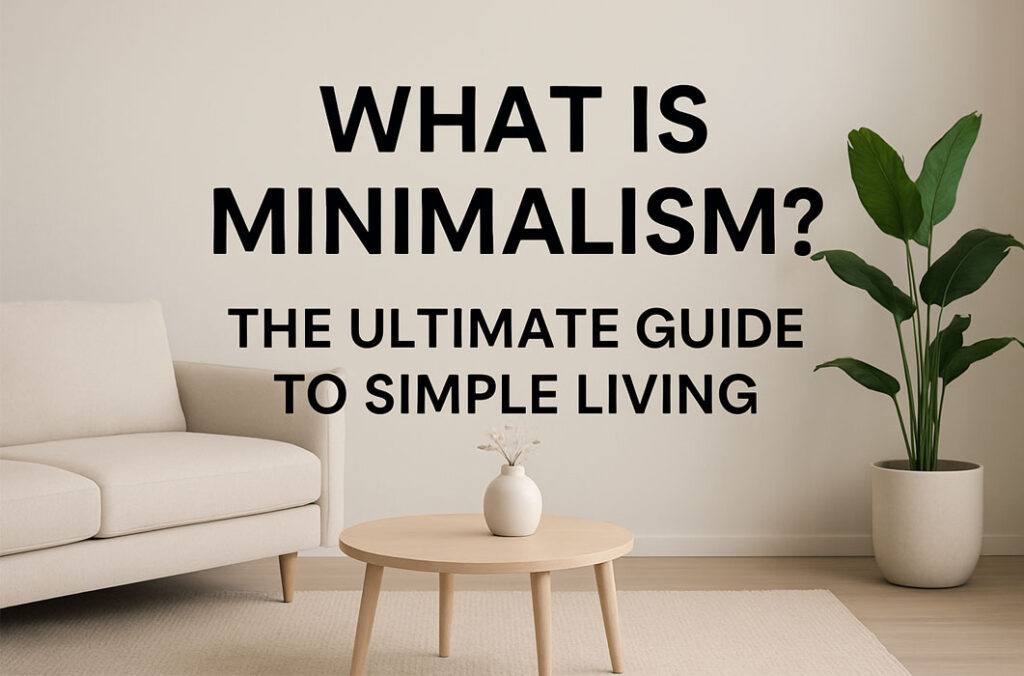Take a look around you. Maybe your desk is covered with papers, your phone has hundreds of unread notifications, and your mind feels as crowded as your closet. Sound familiar?
In today’s fast-paced world, it’s easy to feel buried under possessions, tasks, and digital noise. That’s where minimalism quietly steps in – not as a trend, but as a way to breathe again. What Is Minimalism?
You’ve probably seen it online: spotless homes, capsule wardrobes, or people who seem to live with almost nothing. But here’s the truth – minimalism isn’t really about having less; it’s about making room for more.
More peace. More clarity. More time for the things that truly matter.
In this guide, we’ll explore what minimalism really means, where it comes from, why so many people are turning toward it, and how you can start living more simply – without feeling deprived.
If you’ve ever felt like your life is too full of “stuff” but still somehow empty, this guide will help you reset, refocus, and rediscover what enough actually feels like.
So, what is minimalism really?
At its core, minimalism is intentional living – a conscious choice to focus on what truly matters and remove what doesn’t. It’s not about counting how many things you own or living in an empty room. It’s about keeping only what adds value, time, or joy to your life and letting go of the rest.
Minimalism asks one simple but powerful question: Does this serve me, or does it distract me? When you start viewing life through that lens, everything changes – how you spend your time, where you put your energy, and even how you define success.
There are a few ways people talk about minimalism, and it helps to understand the difference:
- Lifestyle minimalism — This is what most people mean today. It’s about decluttering your space, simplifying your routines, and freeing your mind from constant consumption. The goal isn’t perfection — it’s clarity and peace.
- Design minimalism — You’ve seen it in architecture or interiors: clean lines, open spaces, calm colors. It’s about creating balance and visual harmony so that every element serves a purpose.
- Philosophical minimalism — The deeper layer. Ancient thinkers like the Stoics and Epicureans promoted the same idea centuries ago: live simply, desire less, and find happiness in sufficiency rather than excess.
Minimalism, in the end, isn’t one-size-fits-all. Whether you’re a busy professional trying to manage digital overload, a parent drowning in daily chaos, or someone seeking a lighter footprint on the planet, minimalism offers a way to breathe easier and live more intentionally.
Origins & History: From Philosophy to 21st-Century Movement
Every movement has a story — and the history of minimalism is much deeper than clean desks and white walls.
Before it became an aesthetic, minimalism was a way of thinking — a search for balance, purpose, and peace in a noisy world. Let’s trace how it evolved, from ancient philosophy to the modern lifestyle we know today.
Ancient & Philosophical Roots 🏛️
The origin of minimalism can be traced back thousands of years to ancient wisdom. Greek philosopher Epicurus taught that happiness didn’t come from having more, but from needing less. The Stoics, like Seneca and Marcus Aurelius, echoed the same idea — live with intention, control your desires, and focus only on what’s within your power.
Later, spiritual traditions around the world embraced similar ideas. From Buddhist monks practicing detachment to Indian yogic teachings on simplicity, the core message remained constant: peace comes from clarity, not clutter.
By the 19th and early 20th centuries, thinkers in the voluntary simplicity movement — such as Henry David Thoreau — redefined the idea for modern life. His time at Walden Pond wasn’t just solitude; it was a rebellion against excess, a return to what truly matters.
Design & Art Roots 🎨
Fast forward to the early 20th century — minimalism took a new shape in the world of art and design. The Bauhaus and De Stijl movements in Europe rejected ornamentation and focused on function, form, and space. The mantra was simple: “Less, but better.”
In architecture, pioneers like Ludwig Mies van der Rohe and Le Corbusier introduced clean lines, open layouts, and natural light — creating spaces that felt calm and purposeful. This visual simplicity soon influenced how people viewed their homes, workspaces, and even lives. The minimalist aesthetic became a mirror for a clearer, quieter mindset.
Modern Lifestyle Movement 🌱
The minimalism movement as we know it today truly took off in the 21st century — thanks to writers, filmmakers, and bloggers who turned simplicity into a global conversation.
Joshua Fields Millburn and Ryan Nicodemus, known as The Minimalists, shared their story of leaving corporate success for intentional living. Their blog, books, and Netflix documentaries inspired millions to declutter both their spaces and their minds.
Joshua Becker, founder of Becoming Minimalist, brought a family-centered approach — showing how minimalism could simplify parenthood and create more time for relationships.
In Japan, Fumio Sasaki captured global attention with his deeply personal book Goodbye, Things, reminding readers that letting go of possessions can mean finding yourself.
Together, these voices transformed minimalism from a niche philosophy into a cultural movement — one that challenges the modern obsession with “more” and replaces it with “enough.”
From ancient wisdom to modern design to digital-era simplicity, the history of minimalism shows a timeless truth: when we clear away the excess, we make room for what truly matters — peace, presence, and purpose.
Evidence-Backed Benefits of Minimalism
While minimalism may seem like a personal choice or aesthetic trend, science paints a much richer picture. The benefits of minimalism reach deep into mental health, finances, daily focus, and even our environmental footprint. Let’s explore what the research — and real-life experience — actually tell us.
Mental Health & Focus 🧠
One of the most studied minimalism benefits is its impact on mental well-being. Research published in ScienceDirect found that cluttered homes are strongly linked to increased cortisol levels — the stress hormone that triggers fatigue and anxiety. In simple terms: the mess around you quietly drains your peace of mind.
Another study observed that people who described their homes as “cluttered” reported feeling more depressed and less satisfied with life. Interestingly, researchers noted that “perceived beauty and order” in one’s home mediated well-being — meaning, when your space looks and feels calm, your mind follows suit.
Practical takeaway: decluttering isn’t just about organizing things — it’s about organizing your thoughts. When you remove visual noise, you lower mental friction and reclaim focus for what truly matters: your goals, relationships, and rest.
Financial Freedom & Spending Reduction 💸
Another major benefit of minimalism is how it transforms our relationship with money. Minimalists often report spending less, saving more, and feeling richer in time and satisfaction.
Behavioral research supports this. When people consciously reduce consumption, they often experience higher financial control and less “buyer’s remorse.” Joshua Becker, author of The More of Less, puts it simply — “You don’t need to own everything you want. You just need to want what you already have.”
Jeremy Silva’s financial studies echo this mindset: intentional minimalism helps people focus spending on what aligns with their values — like travel, experiences, or freedom from debt — rather than endless upgrades and impulse buys.
Practical takeaway: minimalism doesn’t mean being cheap; it means being clear. You start spending for meaning, not for mood.
Time & Decision Simplicity ⏰
The hidden minimalist life advantage is time. Every item you own, every outfit you choose, every subscription you manage — demands a small piece of your mental energy. This is what psychologists call “decision fatigue.”
By reducing unnecessary choices, you create more space for meaningful action. Fewer clothes mean faster mornings. Fewer distractions mean deeper work. And less digital clutter means more time for real connections.
As minimalist advocate Courtney Carver says, “You don’t need more time; you just need less to do.”
Practical takeaway: simplifying your surroundings can give you back hours you didn’t know you were losing — not by working harder, but by needing less.
Environmental & Sustainability Angle 🌍
Minimalism also carries an environmental promise — but with nuance. Research reviewed in Wiley Interdisciplinary Reviews (WiRES) shows that people who live minimally tend to consume fewer goods and produce less waste. This naturally lowers their individual carbon footprint.
However, the data isn’t absolute. Some studies suggest that while personal consumption may drop, larger systemic changes — in production, transport, and energy use — are still needed for a significant global impact.
Still, the direction is clear: a minimalist lifestyle encourages mindful consumption, extending product lifespans, and valuing repair over replacement. Even small shifts, multiplied across communities, can make a visible difference.
Practical takeaway: minimalism may not save the planet alone — but it teaches a mindset that could.
In short, the benefits of minimalism go far beyond aesthetics. It’s about mental clarity, financial freedom, and living in rhythm with what truly matters — your time, your values, and your world.
Minimalism Myths & Misconceptions
Minimalism is often misunderstood — and those misunderstandings can scare people away before they even start. Let’s clear the air around the most common minimalism myths, so you can see what this lifestyle is really about.
Myth 1: “Minimalism means living with nothing or cold white spaces.” 🏠
This is one of the biggest minimalism misconceptions — that minimalism equals empty rooms and sterile walls.
In reality, minimalism isn’t about owning nothing; it’s about owning enough.
Designers often remind us that minimalism doesn’t mean boring or lifeless. According to Better Homes & Gardens, modern minimalist design is about intentional warmth — using natural textures, personal accents, and open spaces that feel calm yet lived-in.
Minimalism in life works the same way: it’s not the absence of things, it’s the presence of purpose.
Micro-action: Look around your space and pick one thing that truly brings you peace — a photo, a plant, a candle. Keep it. That’s your kind of minimalism.
Myth 2: “Minimalists must be young, single, or wealthy.” 👨👩👧👦
Another common minimalism myth is that it’s only for a certain type of person — urban creatives, digital nomads, or people with money to spare. The truth? Minimalism is for anyone who wants less stress and more clarity.
The Minimalists often share stories from families, retirees, and working parents who’ve embraced simple living in their own ways. You don’t need designer furniture or a perfect home. You just need the willingness to question what adds real value to your life.
Micro-action: Forget the Pinterest version of minimalism. Instead, ask yourself: “What would a simpler life look like for me right now?” Start there.
Myth 3: “Minimalism is just decluttering once.” 🧺
Many people assume that minimalism ends when the last box of stuff leaves the house. But that’s another minimalism misconception.
Decluttering is just the first step — the visible part of a deeper habit and mindset shift.
True minimalism is about living intentionally day after day: saying no to unnecessary commitments, digital overload, and emotional clutter. It’s a long-term practice of making space — not just in your home, but in your head and heart.
Micro-action: Next time you buy something new, pause and ask, “Does this make my life easier or fuller?” If not, let it go.
When you strip away these minimalism myths, the message becomes simple: minimalism isn’t about perfection — it’s about presence. It’s not about living with less, but about living with meaning.
How to Start Minimalism: Beginner’s Step-by-Step System

Thinking about simplifying your life can feel overwhelming. But how to start minimalism doesn’t have to be complicated. The key is small, deliberate actions that fit your pace and your life. Here’s a field-tested roadmap you can follow, step by step.
Step 1: Before You Begin — Values Audit 📝
Before touching a single item, take 15 minutes to list your top 5 priorities. These could be work, family, creativity, health, or hobbies. The idea is simple: whatever aligns with these priorities stays, and everything else becomes a candidate for letting go.
Example: If “family time” is a priority, keeping a dozen old kitchen gadgets you never use might not make sense. But sentimental photos or meaningful gifts? Those might earn a spot.
This quick values audit ensures your minimalism journey reflects your life, not someone else’s Instagram feed.
Step 2: Declutter Framework Options 📦
Different approaches work for different people. Pick one that feels doable:
- KonMari Method: Keep only what sparks joy. Touch each item and ask, “Does this genuinely make me happy?” If not, thank it and let it go.
- Room-by-Room Sweep: Start with one area — maybe the kitchen, then the closet, then the living room. Small, visible wins create momentum.
- 1-in / 1-out Rule: For every new item you bring in, remove one old item. A simple way to maintain balance without dramatic purges.
- 30-Day Minimalism Challenge: Commit to a small daily task — like decluttering 5 items a day — for a month. The cumulative effect is powerful.
Pick one or combine approaches — the goal isn’t perfection, it’s steady progress.
Step 3: Practical Daily Habits ⏳
Minimalism isn’t just a one-time cleanout; it’s a lifestyle shift. Small, daily habits reinforce it:
- 5-Minute Nightly Reset: Tidy your workspace or living area before bed. A clear space encourages a clear mind.
- Weekly Inbox Zero: Delete unnecessary emails and unsubscribe from cluttering lists. Digital minimalism reduces decision fatigue.
- App & Digital Audit: Evaluate apps and notifications. Keep what serves you, ditch what distracts.
Even tiny daily habits compound into a calmer, more intentional life.
Step 4: Checklist & Sample 30-Day Challenge ✅
Here’s a simple 30-day action plan for beginners:
- Day 1–5: Tackle one drawer or shelf per day.
- Day 6–10: Sort your clothes using the “spark joy” test.
- Day 11–15: Review your digital devices — delete unused apps and organize folders.
- Day 16–20: Assess your kitchen — donate gadgets or duplicates.
- Day 21–25: Declutter books, magazines, and papers. Keep only those meaningful or referenced.
- Day 26–30: Conduct a values check — ensure remaining items truly reflect your priorities.
Pro tip: Celebrate small wins. Even clearing one cluttered shelf or deleting 100 unread emails is progress. Minimalism is a habit, not a one-time task.
By following these steps, beginner minimalists can steadily transform their spaces, minds, and routines. The key is consistency, reflection, and practical small actions — not drastic overnight changes.
FAQ: Minimalism FAQ
1. What is minimalism and how is it different from decluttering?
Minimalism is a lifestyle choice focused on intentional living — keeping what adds value and letting go of what distracts. Decluttering, on the other hand, is a one-time or periodic action of removing excess items. Minimalism goes deeper: it’s about aligning your space, time, and decisions with your values, not just tidying up your home.
2. Is minimalism the same as owning very few things?
No. Owning few things is a common minimalism myth. Minimalism isn’t about deprivation; it’s about intentionality. You keep what truly matters, whether that’s a few items or many — as long as each piece adds value, joy, or purpose to your life.
3. Can minimalism save me money?
Yes. Minimalism encourages mindful spending. By focusing on what you truly need, you reduce impulse purchases and save more. Many people find that their money goes toward meaningful experiences, debt repayment, or long-term goals rather than clutter, making it one of the practical minimalism benefits.
4. How long does it take to become a minimalist?
There’s no fixed timeline. Becoming a minimalist is a gradual process — it can take weeks for small changes or months for a full lifestyle shift. The focus is on consistent reflection, decluttering, and habit-building rather than reaching a strict endpoint.
5. Is minimalism only for certain people?
Absolutely not. Minimalism works for anyone — parents, professionals, retirees, students, or families. The goal isn’t age, wealth, or lifestyle; it’s about reducing distractions and living intentionally. Diversity in practice is what makes minimalism flexible and accessible for everyone.
6. Can minimalism help with anxiety and focus?
Yes. Research shows that cluttered spaces can increase stress and reduce well-being. Minimalism removes distractions, simplifies decisions, and creates calm environments, which can improve attention, mental clarity, and even reduce anxiety. Small daily habits, like tidying or a nightly reset, reinforce these benefits.
7. Does minimalism help the environment?
It can. Living minimally often reduces consumption, waste, and energy use, promoting sustainability. However, global environmental impact depends on broader systemic factors. Even so, mindful consumption and valuing what you own encourages eco-conscious choices, making minimalism a positive, though partial, environmental practice.
8. What are quick daily habits to maintain a minimalist home?
Small routines go a long way: a 5-minute nightly tidy, reviewing and deleting digital clutter, and using the 1-in/1-out rule for new purchases. Consistency is key — even minor actions, done regularly, maintain simplicity without stress.
9. How to deal with sentimental items?
Sentimental items can be tricky. Keep only what genuinely sparks joy or holds important memories. Take photos of items you don’t need physically, or designate a small memory box. The goal is balance: honor memories without letting them take over your space.
Final Thought: Embracing Minimalism in Your Life
Minimalism isn’t about perfection, colorless spaces, or owning the least possible. It’s about clarity, intention, and freedom. By consciously choosing what adds value to your life — from possessions to habits, commitments, and digital distractions — you create space for what truly matters: your time, your relationships, and your peace of mind.
The journey may start with decluttering a drawer or deleting an app, but over time it becomes a lifestyle — a mindset that lets you focus on purpose rather than possessions. Minimalism teaches us a simple truth: living with less doesn’t mean missing out; it means making room for more of what counts.
Start small, reflect often, and remember: minimalism is personal. Your version will look different from anyone else’s, and that’s exactly the point. The ultimate reward is a life designed by you, not by clutter or external expectations.
🌟 Discover, Love & Connect Today! 🌟
💖 Want to strengthen your bond?
👉 Read our full guide: Love Language Guide – Connection in Relationships
🧠 Ever wondered why we feel anxious?
👉 Learn more in: What is Anxiety & Why We Feel It
🌍 Join our inspiring community!
👉 Follow E-Vichar on Facebook
✨ Your journey to deeper love, clarity, and inner peace begins here. ✨
Suggested Sources to Cite
- Becoming Minimalist — What Is Minimalism?
“Minimalism means intentionally promoting the things we most value and removing everything that distracts us.”
→ Use when defining what is minimalism?
Link: https://www.becomingminimalist.com/what-is-minimalism/ becomingminimalist.com - Wiley Review — “Could a minimalist lifestyle reduce carbon emissions …”
Use this when discussing minimalism & sustainability, showing that carbon reduction claims are promising but still inconclusive.
Link: https://wires.onlinelibrary.wiley.com/doi/10.1002/wcc.865 wires.onlinelibrary.wiley.com - The Minimalist Vegan — What Is a Minimalist Lifestyle?
Useful for explaining minimalist lifestyle vs design, and the idea of removing distractions to focus on essentials.
Link: https://theminimalistvegan.com/what-is-minimalism/ The Minimalist Vegan - Better Homes & Gardens — Minimalism Myths
Good source for debunking interior / design myths (e.g. “minimalism = cold white spaces”).
Link: https://www.bhg.com/myths-about-minimalism-11763416 Better Homes & Gardens - “Fashion Consumption Using Minimalism” (Journal Article)
For evidence in minimalism benefits & sustainable consumption, social connectedness, well-being.
Link: https://ideas.repec.org/a/eee/joreco/v71y2023ics0969698922003083.html IDEAS/RePEc




